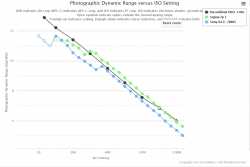[23 / 3 / 1]
Digital Medium Format (Macro Four Thirds) doesn't make any sense as a format.
>most lenses for MFT hover around f/4, with some fast primes around f/1.7. With a crop factor of only x0.79, means you get an equivalent DOF of f/3.16 and f/1.34 respectively . Meaning that full frame actually has shallower dof in most cases.
Another drawback of the f/4 average is that the aperture opening is the same meaning that the iso on MFT needs to be higher (or shutter speed slower) in order to match the exposure on an equivalent FF lens.
>there is no consistent dynamic range advantage.
This was the second best dynamic range MFT camera I could find on photonstophotos (besides a Phase One IQ4 ($62,000)
As you can see the Hassleblad HD6 is only 1(one) stop better than an a7riii at base iso, at iso 100 there is only about 1/2 a stop difference. At 400 ISO the Sigma FP-L actually surpasses the DR from the Hassleblad. Also remember you're iso on the MTF camera will need to be higher throughout to match the exposure of the FF camera.
So what are we left with? Medium format is slower, vastly more expensive, has a deeper DOF and doesn't even have a significant dynamic range advantage past the base iso under a nearly best case scenario. The older MTF cameras often have WORSE dynamic range than a modern FF camera.
There quite simply is no performance-oriented reason to buy a medium format camera except where maximum resolution is required. Having more physical space for the pixels.
Digital medium format is simply a luxury buy and if it wasn't for the social signaling and rarity, it would be going extinct like it's micro cousin.
*drops mic*
>most lenses for MFT hover around f/4, with some fast primes around f/1.7. With a crop factor of only x0.79, means you get an equivalent DOF of f/3.16 and f/1.34 respectively . Meaning that full frame actually has shallower dof in most cases.
Another drawback of the f/4 average is that the aperture opening is the same meaning that the iso on MFT needs to be higher (or shutter speed slower) in order to match the exposure on an equivalent FF lens.
>there is no consistent dynamic range advantage.
This was the second best dynamic range MFT camera I could find on photonstophotos (besides a Phase One IQ4 ($62,000)
As you can see the Hassleblad HD6 is only 1(one) stop better than an a7riii at base iso, at iso 100 there is only about 1/2 a stop difference. At 400 ISO the Sigma FP-L actually surpasses the DR from the Hassleblad. Also remember you're iso on the MTF camera will need to be higher throughout to match the exposure of the FF camera.
So what are we left with? Medium format is slower, vastly more expensive, has a deeper DOF and doesn't even have a significant dynamic range advantage past the base iso under a nearly best case scenario. The older MTF cameras often have WORSE dynamic range than a modern FF camera.
There quite simply is no performance-oriented reason to buy a medium format camera except where maximum resolution is required. Having more physical space for the pixels.
Digital medium format is simply a luxury buy and if it wasn't for the social signaling and rarity, it would be going extinct like it's micro cousin.
*drops mic*

